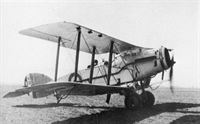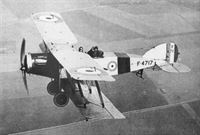Фотографии
-
Регистрационный номер: J6782 Getting away - J6782 of No. 31 Squadron leaving Fort Dardoni, NWFP, India, for a recce in 1923, with Flg Off Ford as pilot.
Самолёты на фотографии: Bristol F.2A/F.2B Fighter - Великобритания - 1916
-
Регистрационный номер: J6786 Two Bristol Fighters from No. 2 Squadron over RAF Mansion in the mid 1920s.
Самолёты на фотографии: Bristol F.2A/F.2B Fighter - Великобритания - 1916
-
Регистрационный номер: C801 A No. 5 Squadron “Brisfit” - in this case C801.
Самолёты на фотографии: Bristol F.2A/F.2B Fighter - Великобритания - 1916
-
Bristol F.2b, “L” of No. 20 Squadron, India, taken in the late 1920s.
Самолёты на фотографии: Bristol F.2A/F.2B Fighter - Великобритания - 1916
-
Регистрационный номер: J6647 Khyber tourist - J6647 of No. 20 Squadron seen at 1,000ft over a section of the infamous Khyber Pass, India, on December 9, 1925. Note the squadron commander’s “streamers” on wings and tail - a distinguishing sign derived from WWI days.
Самолёты на фотографии: Bristol F.2A/F.2B Fighter - Великобритания - 1916
-
Регистрационный номер: J6663 Bristol F.2b, J6663, “B”
Самолёты на фотографии: Bristol F.2A/F.2B Fighter - Великобритания - 1916
-
Регистрационный номер: D8084, G-ACAA Fighting colours - D8084 of No. 139 Squadron, Villaverla, Italy, in September 1918, displaying the unit's black/white hooping on its fuselage and upper wing.
Самолёты на фотографии: Bristol F.2A/F.2B Fighter - Великобритания - 1916
-
Регистрационный номер: H1398 Peaceful fighter - a two-seat conversion for pure communication and general “hack” work. The rather pristine condition of H1398’s fabric seems to suggest VIP usage.
Самолёты на фотографии: Bristol F.2A/F.2B Fighter - Великобритания - 1916
-
Регистрационный номер: F4717 Bristol F.2b, F4717 of 2 (AC) Squadron from Manston, Kent. Pilot Fg Off Jordan, and LAC Watkins as passenger. The fuselage bands were No. 2 Squadron’s unofficial markings - two outer red bands, with centre band in Flight colour, i.e. White (A), Yellow (B), Blue (C).
Самолёты на фотографии: Bristol F.2A/F.2B Fighter - Великобритания - 1916
-
Регистрационный номер: A3303 The first of the "Biffs" - A3303, the prototype F.2A in original state, with twin flank radiators, end plates to lower wing roots and no provision for rear armament.
Самолёты на фотографии: Bristol F.2A/F.2B Fighter - Великобритания - 1916
Статьи
- -
- News Spotlight
- Personal album
- Short Shetland /Press Debut/
- Sikorsky R-4 Hoverfly /Preservation Profile/ (17)
- Skywriters
- ??? - Hendon Pageantry 1920-37
- ??? - Puddle-jumper from Lake
- A.Ord-Hume - Jim Bede's Micro planes
- B.Gunston - SEPECAT Jaguar /Design analysis/ (9)
- B.Martin - Britain's civil aircraft register
- C.Bowyer - Biffs and Brisfits
- C.West - A Cat on the Russian route









